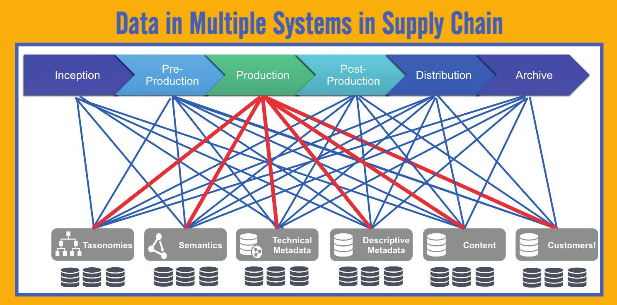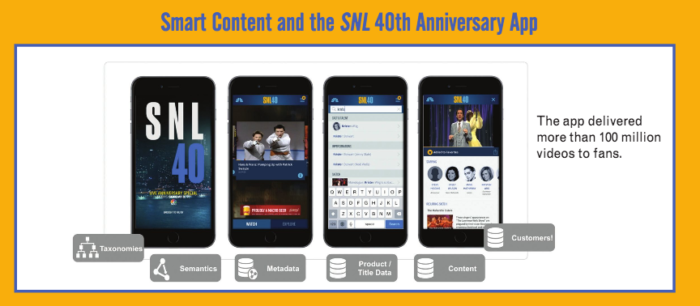Exclusives

M&E Journal: Smart Content Makes an Impact on the Entire Supply Chain
Story Highlights
By Matt Turner, CTO Media & Entertainment, MarkLogic –
The data that is generated as M&E organizations initiate, produce, manage and distribute content has never been more complex or valuable. Linking that data together can have big impacts on aspects of that content creation supply chain from creating great experiences to speeding the creation of the content. However, significant barriers exist that are holding back organizations from effectively sharing and leveraging this valuable information.
This paper will outline the challenges organizations face in bringing together this data and highlight organizations taking new approaches to bringing this information together and lay the groundwork for organizations of all kinds to realize the benefits of an integrated view of data across their entire content creation supply chain.
In a typical organization, data is generated in every step of the process to deliver great content to fans and users.
These stages might include:
- Inception: research and development of content and the initialization and funding of projects.
- Pre-production – establishing the infrastructure to create the content.
- Production – the entire ecosystem of tools and processes to create the content.
- Post-production – Mastering and curation of the content.
- Distribution – delivery of the content to partners or directly to fans and users.
- Archive – enabling the accessibility of the assets for re-distribution, custom re-use and component re-use. Across all of these stages of the supply chain, there is a common set of data that is created, managed and required by the systems in that stage. This data may include:
- Content – assets such as scripts, notes, costume data, production schedules and all other content related to the project.
- Metadata – including descriptive metadata with marketing and product data and technical metadata with asset information.
- Semantics – relationship data that links the metadata and content together with taxonomies and ontologies.
- Taxonomies and Ontologies – data that describes how all the information links together. This can include genre, content domain models for types of content, and master data ontologies for titles, talent and products.
During every phase of the supply chain, systems and processes need access to all of this data. For example, during distribution, systems need to access not just the asset information but also production data. Information around items like wardrobe and props allow organizations to take advantage of new positioning and marketing opportunities. Access to taxonomies and ontologies help deliver unique customized fan experiences.
The other stages of content creation also access and share this same data. Title and foundational descriptive data created during inception are needed in every stage of production to avoid re-entering and duplicating that data. The foundational taxonomies and ontologies that shape the data around the content can inform how production assets are created and organized, creating efficiencies as they are readied for distribution.
As entertainment companies deliver directly to consumers, the availability of customer data also adds to this complexity. This data can inform the inception process, shape how the asset is produced and streamline and customize how it is delivered.

Making this more complex is that there are hundreds or even thousands of systems creating and managing data across all the stages of the supply chain. For example, advances in digital production have led to an explosion of data generating systems for just a single show or film – a situation that is multiplied by the hundreds for the largest entertainment companies.
The result is that data needed to be shared is not just in many different parts of the supply chain; it is in many different systems, all tailored to support their specific functions in the supply chain.
This complex picture means that effectively sharing data is a complex task beyond just joining data from several systems.
Traditional approaches
To bring complex data together, organizations may try to leverage traditional technology, including relational databases and extract, transform and load (ETL) processes that have many limitations.
These systems require you to model upfront the way the data will be used for a given activity. This determines in advance the way the data is stored and how it will be retrieved. For data in the supply chain this is a good fit for single purpose systems, but it can be a significant barrier to bringing data together for multiple purposes. This also means that data going into these systems have to be transformed to fit the schema, resulting in complex and costly ETL processes.
Finally, to manage new data, the schemas and ETL processes need to be redesigned and re-executed.
Across all industries these approaches are becoming a costly and time consuming part of bringing data together. By some estimates up to 60 percent of the cost of data projects in spent with ETL and traditional data integration projects.
In the fast changing world of media, these limitations can pose real challenges to delivery new data to so users can make better choices and the business can take advantage of new market opportunities.
A new approach
To meet these challenges, M&E organizations have been using smart content, the mix of NoSQL data and semantic data.
To bring content data together, these organizations leverage NoSQL’s schema flexibility, enabling data from multiple sources – even the hundreds or thousands across the supply chain – to be loaded and managed in a single system. This approach captures the complete picture of data in the source systems, accommodates new data and new sources, and lets that data be used for new purposes without having to rebuild the system.
To fully capture the context of data, media organizations are also using smart content to describe and link data using semantic structures. This allows organizations to use taxonomies and ontologies to model and manage complex relationships in data. This includes classifications, genres and relationships between titles and products. For forward- looking organizations, it also includes how characters, films and series fit together.
Smart content in action
In February of 2015, NBC celebrated the 40th anniversary of its iconic show Saturday Night Live. As part of the promotion, it created its new SNL app. This application used smart content to combine data from the many years of pre-production and production systems. NBC linked and enriched that data with semantic ontologies for delivery through the app.
In combining the different types of data from the supply chain, the NBC team was able to fully leverage information and create a unique experience for fans of the show. The app was highly successful, holding the number one position in the app store for a couple of weeks and delivering over 100 million videos to fans.
Taking these concepts further in another industry, the information provider Mitchell1 has used these principles to connect data from the automotive repair supply chain, gain new insights and create efficiencies for their customers, the garage mechanics.

Mitchell is part of the Snap-On group and delivers systems that manage every part of the automotive repair cycle including diagnostics, estimating, parts ordering, repair procedure, billing and input from expert mechanics. Using smart content, it was able to combine this data and now can leverage data from parts ordering and billing to create better diagnostic tools based on previous repair experience.
An example of what is possible in the entertainment space is The Suitcase Project from The Entertainment Technology Center at the University of Southern California (ETC@ USC). This project, led by Erik Weaver, the Senior Program Manager of “Project Cloud”, looks at many critical issues in movie production including using these new approaches to bring together data from across the digital supply chain and ensure data created during production doesn’t need to be re-created downstream. This includes script, camera and production data along with post production and mastering information.
The smart content solution
These projects all demonstrate the potential for smart content to handle the diversity and complexity of the M&E supply chain. Using these new approaches, M&E organizations can manage and connect data from across the supply chain with a single system.
Such a system uses the principles of smart content to store and manage data true to the source systems in the chain, while linking and delivering data to other systems in the context needed for each stage in the supply chain.
Conclusion
Connecting all the data and content across the digital supply chain has never been more important to M&E organizations. Data from pre-production and production can provide critical capabilities in the new world of custom and tailored delivery. Usage and delivery information can impact the re-use of assets during production. The archive process can efficiently provide access to assets with this complete picture of the data.
With smart content, M&E organizations are linking this data together to create unique distribution experiences, connect data in the production cycle and are showing, today, the impact of using this critical data across the entire supply chain.
Click here to translate this article
Click here to download the complete .PDF version of this article
Click here to download the entire Spring 2016 M&E Journal









